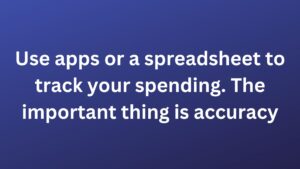Track your spending
Tracking your spending isn’t merely about keeping tabs on where your money goes; it’s about controlling your financial destiny. By looking into the intricacies of your expenses, you gain the power to steer your finances toward your aspirations. Imagine a world where every dollar spent is a deliberate step towards your dreams—this is the essence of tracking your spending. So, let’s embark on this journey together, where we uncover how to improve my budget and how to save money, the secrets to financial empowerment and unlocking the path to realizing your goals, and =set clear financial goals. An effective way of setting financial goal is to =create a realistic budget=, and discover practical ways to save money—all through the simple yet profound act of “Track your spending.”
Track your spending
Tracking your spending isn’t just about scrutinizing your financial transactions; it’s about casting a vision for your future. Have you ever daydreamed about leaving your current job, perhaps to retire early, pursue a passion project, or embark on an adventure? Whatever your aspirations, tracking your spending provides the road map to turn those dreams into reality. By meticulously monitoring your expenses, you gain insights into where your money is going and where you can cut back to allocate funds toward your goals. After all, the essence of money lies in its ability to facilitate the attainment of your desires and necessities. So, let tracking your spending guide you toward a life of financial freedom and fulfillment.
How to track your money
To effectively track your money, start by logging all your purchases. This means recording every expenditure, regardless of how small, using a dedicated app or an Excel spreadsheet. Establishing this habit is vital as it provides a clear picture of your spending patterns. Consistently recording transactions allows you to identify areas where you may be overspending or where you can make adjustments to save money. Additionally, consider utilizing technology to streamline the process and make it more convenient. With commitment and consistency, tracking expenses becomes second nature, enabling you to take control of your finances efficiently.
Categorize your spending
Categorizing your spending is a crucial step in understanding your financial habits. You gain clarity on where your money is going by grouping your expenses into categories like groceries, entertainment, utilities, and transportation. This breakdown allows you to pinpoint areas where you may be overspending or where you can afford to cut back. By closely monitoring your expenditure in each category, you can make informed decisions about allocating your funds more effectively. This practice lets you prioritize your spending based on your financial goals and helps you maintain better control over your budget.
Analyze and Adjust
Analyzing and adjusting your spending habits is the next crucial step after tracking your expenses for a month. Take the time to review your spending patterns and identify areas where you can cut back or reallocate funds. You gain valuable insights into your financial habits and priorities by closely examining your spending log. This process empowers you to make more efficient decisions about managing your money. Whether it’s reducing unnecessary expenses or reallocating funds to prioritize your financial goals, analyzing your spending allows you to take control of your finances and make positive changes for the future.
Set financial goals on your insight.
Utilize the insights gained from analyzing your spending to set meaningful financial goals. If you discover areas where you can reduce spending, consider reallocating those funds towards savings or other priority categories. Whether you aim to bolster your emergency fund, save for future investment, or indulge in that dream vacation, align your spending adjustments with your overarching financial objectives. By leveraging your newfound awareness of your spending habits, you can make intentional decisions to achieve your financial goals and cultivate a more secure financial future. “Track your spending” consistently to ensure that your financial choices align with your goals and priorities.
Repeat and reuse
Make tracking your financial outflows and adjusting your budget and goals a regular practice. Conduct regular audits of your expenses to ensure you stay on track with your financial objectives. This review process should become a habitual part of your routine, helping you stay aware of your spending patterns and identify areas for improvement. Track your expenses as you spend to avoid overlooking any transactions, ensuring your financial records remain comprehensive and accurate.
Conclusion
Tracking your spending is not just about monitoring where your money goes; it’s a practice that aligns your financial habits with your dreams and aspirations. Whether you envision early retirement, a career change, home ownership, or the vacation of a lifetime, understanding and managing your finances is the key to turning these visions into reality. By adopting a disciplined approach to record, categorize, and review your expenses, you empower yourself to make strategic decisions that optimize your financial resources. This habit of financial vigilance ensures every available dollar is purposefully directed towards your goals, offering clarity and control over your economic future. The essence of money management lies in its ability to open doors to your needs and desires. Start your financial journey today and take the first step towards realizing your dreams. “Track your spending” consistently and watch as your financial aspirations transform into tangible achievements.



